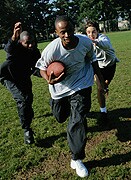- Navigating Your Midlife Crisis: Embracing New Possibilities
- City Raccoons Showing Signs of Domestication
- Mapping the Exposome: Science Broadens Focus to Environmental Disease Triggers
- One Week Less on Social Media Linked to Better Mental Health
- Your Brain Changes in Stages as You Age, Study Finds
- Some Suicide Victims Show No Typical Warning Signs, Study Finds
- ByHeart Formula Faces Lawsuits After Babies Sickened With Botulism
- Switch to Vegan Diet Could Cut Your Greenhouse Gas Emissions in Half
- Regular Bedtime Does Wonders for Blood Pressure
- Dining Alone Could Mean Worse Nutrition for Seniors
Bullied Teens Who Exercise May Lower Suicide Risk, Study Finds


Regular exercise may lower bullied teens’ risk of suicide, researchers report.
The researchers analyzed data from more than 13,500 U.S. high school students and found that being physically active four or more days a week reduced bullied teens’ suicidal thoughts and attempts by 23 percent.
The researchers also found that about 30 percent of bullied teens said they had felt sad for two or more weeks in the previous year; 22 percent thought about suicide; and more than 8 percent attempted suicide in the previous year. About 20 percent of the students said they had been bullied on school property.
Bullied students were two times more likely to report sadness and three times more likely to think about or attempt suicide than those who weren’t bullied.
Physical activity on four or more days a week also led to large reductions in sadness, the researchers said.
The study was published recently in the Journal of the American Academy of Child & Adolescent Psychiatry.
“I was surprised that it was that significant and that positive effects of exercise extended to kids actually trying to harm themselves,” study author Jeremy Sibold said in a University of Vermont news release. Sibold is associate professor and chairman of the university’s department rehabilitation and movement science.
While the study showed an association between physical activity and suicide risk, it did not prove a cause-and-effect link.
“Even if one kid is protected because we got them involved in an after-school activity or in a physical education program, it’s worth it,” Sibold added.
But, many U.S. schools have significantly cut students’ opportunities for physical activity, he noted.
“It’s scary and frustrating that exercise isn’t more ubiquitous and that we don’t encourage it more in schools,” Sibold said. “Instead, some kids are put on medication and told ‘good luck.’ If exercise reduces sadness, suicide ideation and suicide attempts, then why in the world are we cutting physical education programs and making it harder for students to make athletic teams at such a critical age?”
More information
The U.S. Centers for Disease Control and Prevention offers advice on children and physical activity.
Source: HealthDay
Copyright © 2025 HealthDay. All rights reserved.










